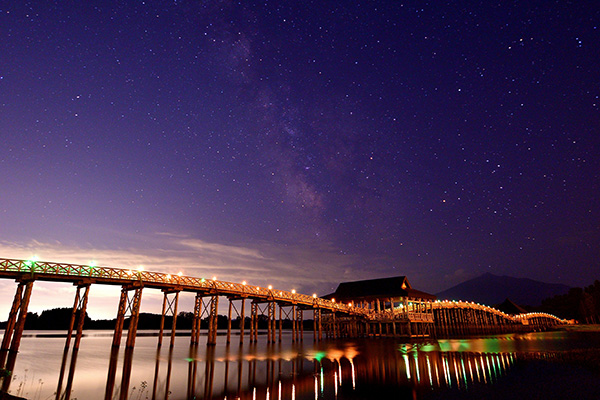September 2023
- English
- 日本語
Tsuru-no-Mai Bridge: A Beautiful Wooden Structure Resembling a Crane with Spread Wings
-

The bridge forms beautiful arches set against the foothills of Mount Iwaki, the "Tsugaru Fuji."
Photo: Tsuruta Town Hall -

The structure of the bridge was inspired by a desire to pass down to the next generation the warm ambience of wood.
Photo: Tsuruta Town Hall
-

Every 100 meters, at the foot of each arch, there are azumaya stages.
Photo: Tsuruta Town Hall -

The changing expressions of the Tsuru-no-Mai Bridge throughout the four seasons of Aomori
Photo: Tsuruta Town Hall

Photo: Tsuruta Town Hall
The Tsuru-no-Mai Bridge is a triple drum wooden bridge* that spans Lake Tsugaru Fujimi in Tsuruta Town, Aomori Prefecture. Sakaiya Sakiho, an official of the Tourism Planning Division at the Tsuruta Town Hall explains the appeal of the bridge.
Shaped like a crane spreading its wings, the Tsuru-no-Mai ("crane's dance" in Japanese) Bridge blends seamlessly into the lakeside scenery, creating a beautiful sight. Despite its wooden structure, which evokes the image of Japanese traditional style, the bridge is surprisingly new, having been built in 1994. It was constructed over Lake Tsugaru Fujimi for the purpose of monitoring and checking the condition of the water in the lake, which also serves as a reservoir, and for sightseeing purposes.

Photo: Tsuruta Town Hall
"Since ancient times, this area has been called 'Tsugaru,' and Mount Iwaki (elevation 1,625 meters), which resembles Mount Fuji when viewed from this location, is also known as the 'Tsugaru Fuji.' In 1660, Nobumasa, the 4th lord of the Hirosaki clan,** which ruled the Tsugaru region, built an embankment to facilitate the development of new rice paddies. He also created a large reservoir,*** which was named Lake Tsugaru Fujimi, because its surface reflected Tsugaru Fuji," explains Sakaiya.
She also provided details about the Tsuru-no-Mai Bridge.
"It is a 300-meter-long triple drum bridge constructed entirely of Aomori cypress. The pier is build using 700 Aomori cypress trees that were more than 150 years old, applying traditional Japanese wooden architecture techniques, in order to maintain harmony with the surrounding natural environment and the landscape."
Azumaya stages are located every 100 meters. They can be used for rest and for holding small-scale events, making the Tsuru-no-Mai Bridge a place for recreation and relaxation for the local people.

Photo: Tsuruta Town Hall
According to Sakaiya, there is also an interesting story about the numbers related to the Tsuru-no-Mai Bridge.
"We were looking for the number three in connection to its structure as a triple drum bridge, when we discovered that, by pure coincidence, this number was related to almost every element of the Tsuru-no-Mai Bridge."
Indeed, the bridge is 300 meters long and three meters wide, with pier columns 30 centimeters in diameter, and was made using 3,000 logs and 3,000 planks. The number three is truly everywhere.
"In fact, a straight line links the bridge with Kannon Hakkakudo, an octagonal Buddhist pagoda dedicated to the Deity of Mercy, Kannon enshrined on the grounds of the nearby Fujimi Lake Park. The many associations of the bridge with the number three, which is considered auspicious in Japan, gave birth to a widespread belief that it is part of a 'mysticalpath' leading to the Deity of Mercy. Today, the bridge is drawing attention as a spiritual place for good fortune and longevity."
But, above all, the main attraction of the Tsuru-no-Mai Bridge is the beautiful harmony between the bridge and the magnificent nature of the Tsugaru region that brings it into focus.

Photo: Tsuruta Town Hall
"In spring, the Tsuru-no-Mai Bridge can be enjoyed against the backdrop of cherry blossoms, and in fall, it is highlighted by crimson foliage. The bridge looks particularly attractive in winter when it's like putting on a hat of pure white snow. In autumn and winter, when the air is crisp and clear, the sight of the Tsuru-no-Mai Bridge illuminated under the starry skies is truly spectacular."

Photo: Tsuruta Town Hall
"This September marks 30 years since the construction of the bridge. Because of aging of the structure, it will undergo a major renovation over a period of three years, from 2023 through 2025. Renovation work will be conducted from September 1 to March 31 of each year. The Tsuru-no-Mai Bridge will be closed to all traffic until construction is completed, but visitors will be able to view the exterior of the bridge as it is. We have also scheduled special events during the renovation period, and we hope visitors will enjoy them."
* A semicircular highly-arched bridge is called a "drum bridge" because its form makes a full circle when reflected in the water, suggesting the shape of a round drum. Three linked drum bridges are called a "triple drum bridge."
** The Hirosaki clan ruled the Tsugaru region of Mutsu Province, which roughly corresponds to present-day Aomori Prefecture, during the Edo period (1603 – late mid-19th century). It was also known as the Tsugaru clan and governed the western part of what is now Aomori Prefecture.
*** Officially named Mawarizeki Otameike, it is the largest reservoir lake in Aomori Prefecture.

